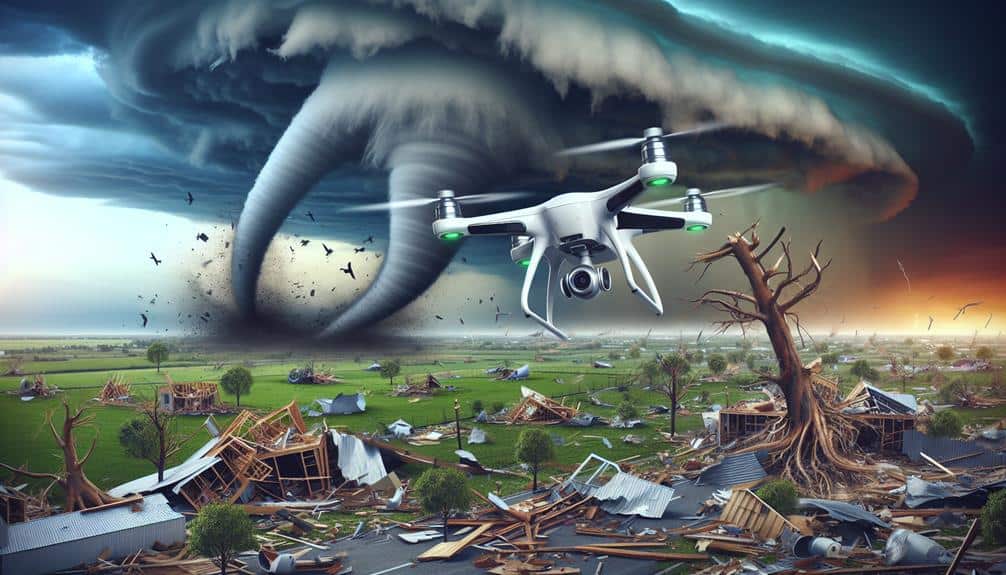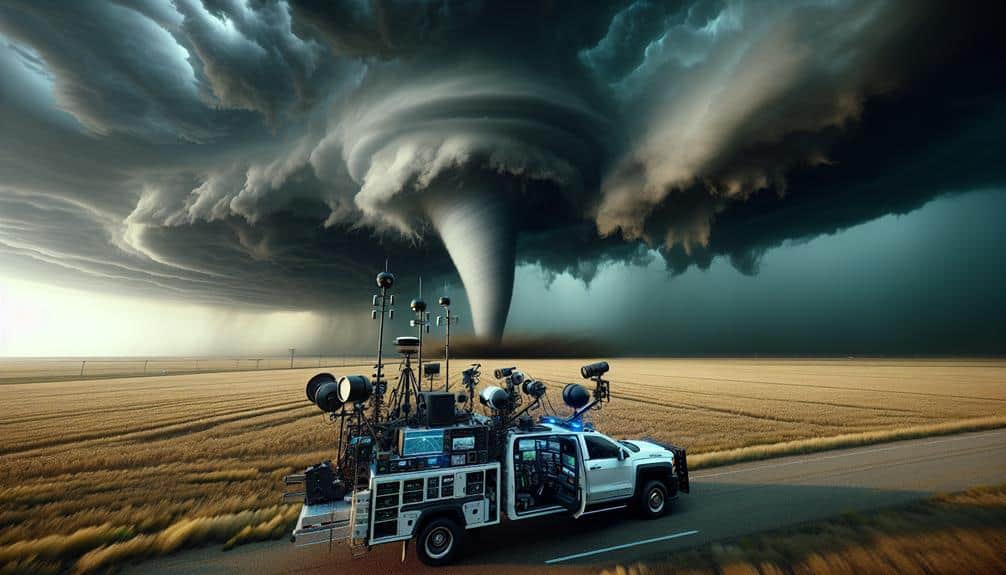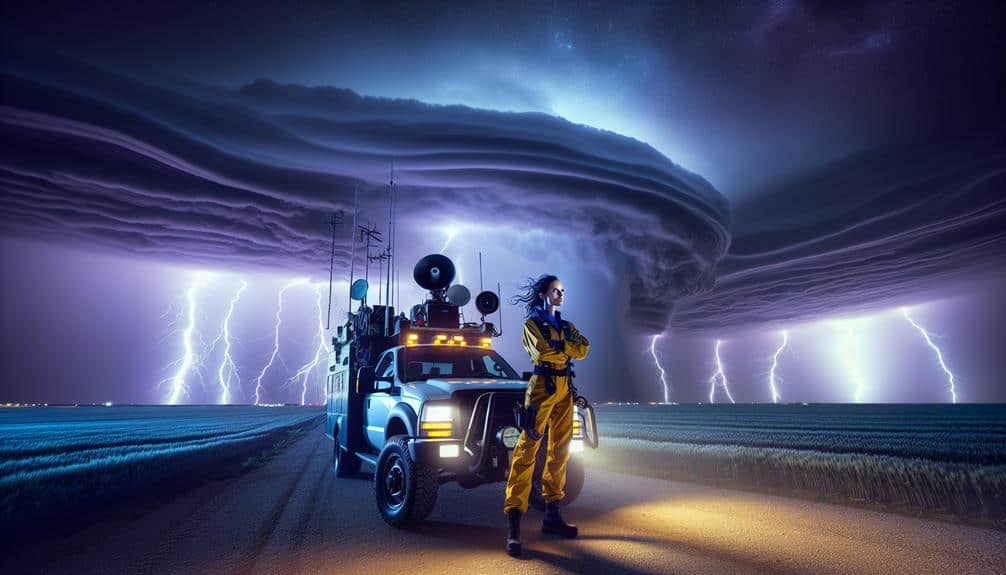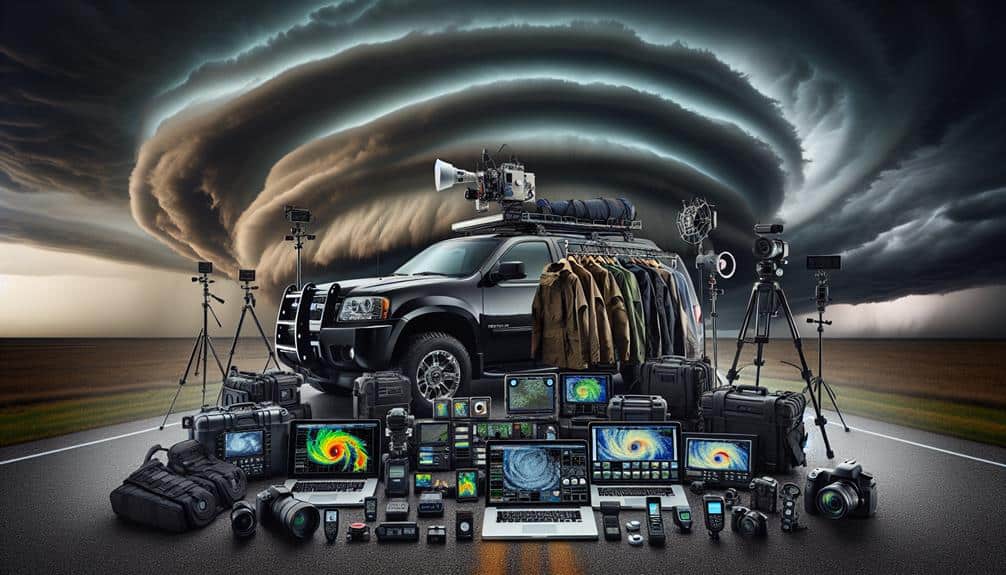We'll master storm chasing drone techniques by first selecting drones with strong wind resistance, high-powered motors, and high-resolution sensors. Next, we carefully prepare by monitoring weather, checking equipment, and updating firmware. During flight, we conduct risk evaluations and maintain clear communication for safety. For capturing footage, we use high frame rates, adjust ISO and aperture settings, and experiment with angles. Post-storm, we review footage for damage assessment and analyze data to enhance forecasting. Following these steps guarantees we capture striking, informative storm footage while staying safe. Continue on to explore advanced tips and crucial insights.
Key Points
- Select drones with strong wind resistance, powerful motors, and high-quality gyroscopes for stability in turbulent conditions.
- Conduct thorough pre-flight preparations, including battery checks, propeller inspections, and firmware updates, to ensure equipment reliability.
- Use real-time meteorological tools and conduct pre-flight risk assessments to establish safety measures and emergency procedures.
- Adjust camera settings for high frame rate, ISO, and aperture to capture clear and detailed footage of the storm.
Drone Selection
When it comes to drone selection for storm chasing, we need to prioritize models with strong wind resistance and advanced stabilization features. The unpredictable conditions demand drones equipped with powerful motors and high-quality gyroscopes to maintain stability in strong winds. Look for drones with specifications indicating resistance to wind speeds of at least 30 mph.
Additionally, advanced stabilization features like 3-axis gimbals are essential for capturing clear footage in turbulent air.
We must also consider the drone's camera quality. High-resolution sensors, preferably 4K, and a wide dynamic range are vital for detailed imagery. Equally significant are long-range transmission capabilities; a minimum of 5 kilometers guarantees we can maintain control and receive real-time data from a safe distance.
Budget considerations play a significant role in our selection process. High-end models, such as the DJI Mavic 3, offer superior features but come with a substantial price tag. Mid-range options like the Autel Robotics EVO II provide a balanced mix of performance and affordability.
Pre-Flight Preparations
Choosing the appropriate drone sets the stage, but careful pre-flight preparations guarantee our equipment performs at its peak during storm chases.
First, we need to monitor weather conditions meticulously. Utilizing advanced weather monitoring tools ensures we've up-to-the-minute data on wind speeds, precipitation, and atmospheric pressure. This information is crucial for determining safe flight windows and best launch sites.
Next, we turn to our equipment checklist. Every item must be inspected and confirmed. Batteries should be fully charged and spare ones packed. Check the drone's propellers for any signs of wear or damage, as compromised propellers can lead to catastrophic failures. Verify the camera and sensors are clean and functioning correctly, as they're essential for capturing high-quality data and imagery.
We also need to confirm the firmware of our drone and remote controller. Outdated software can introduce glitches or compatibility issues, jeopardizing the mission. Don't forget to calibrate the drone's compass and GPS to enhance navigational accuracy.
Packing essential tools like a screwdriver set, extra memory cards, and a first aid kit can make a significant difference in the field.
Flight Safety Protocols
Ensuring flight safety procedures are meticulously followed is paramount to both successful data collection and the safety of our team. When it comes to storm chasing, we can't afford any oversight. Our risk assessment process must be thorough, evaluating potential hazards and outlining clear emergency procedures.
Effective weather monitoring is essential. We need real-time data to make informed decisions about flight paths and times. Utilizing advanced meteorological tools, we can track storm developments and adjust as needed.
Communication strategies are another cornerstone of our safety protocols. Continuous communication between the flight operator, ground team, and weather analysts ensures everyone is on the same page. Clear, concise information flow can prevent misunderstandings that might lead to accidents.
To guarantee we're prepared, we follow a detailed checklist:
- Pre-Flight Risk Assessment: Evaluate all possible hazards and establish safety measures.
- Real-Time Weather Monitoring: Use meteorological tools for up-to-date weather data.
- Emergency Procedures: Establish and rehearse steps for various emergency scenarios.
- Communication Protocols: Maintain constant and clear communication among team members.
Capturing High-Quality Footage
Achieving high-quality footage during storm chasing requires precise drone maneuvering and best camera settings. To capture the dynamic energy of a storm, we need to set our drone's camera to a high frame rate, ideally 60 fps or higher. This guarantees smooth motion capture.
Adjusting the ISO is essential; too high, and we risk noise, too low, and we lose detail in low-light conditions. We should aim for an ISO of 400-800 depending on the lighting conditions. Aperture settings play a crucial role in defining depth of field. A narrower aperture (higher f-stop) will keep more of the scene in focus, which is necessary when capturing vast storm landscapes.
Properly calibrating white balance can also enhance the color accuracy of our footage, making post-processing more efficient.
Drone angles are essential in showcasing the storm's scale and intensity. Low-angle shots can dramatize the towering clouds, while higher angles provide a detailed view of the storm's breadth. Combining different angles in our footage will make it more engaging.
After capturing, our editing techniques come into play. Using software like Adobe Premiere or Final Cut Pro, we can refine our footage, adjust exposure, and stabilize shaky shots, making sure our final product is polished and professional.
Post-Storm Analysis

After capturing and refining our footage, we turn our attention to post-storm analysis to evaluate the storm's behavior and gather valuable meteorological data. Analyzing the storm's characteristics helps us understand its impact and improve future predictions.
Our post-storm analysis focuses on several key areas:
- Damage Assessment: We meticulously review the footage to quantify the storm's destruction. This involves identifying areas of structural damage, downed power lines, and other significant infrastructure issues.
- Weather Patterns: By examining the data captured, we can identify specific weather patterns that contributed to the storm's intensity and path. Understanding these patterns is vital for enhancing predictive models.
- Environmental Impact: We assess how the storm affected local ecosystems. This includes evaluating changes in vegetation, water bodies, and wildlife habitats.
- Emergency Response: Our analysis helps inform emergency response strategies. By pinpointing the most affected areas, we can direct resources more efficiently and aid in quicker recovery efforts.
Our post-storm analysis is necessary for advancing our knowledge and enhancing community resilience against future storms.
Frequently Asked Questions
How Can I Predict the Path of a Storm Accurately?
We can predict the path of a storm accurately by leveraging advanced storm tracking technology. By analyzing weather patterns and utilizing path forecasting models, we enhance our accuracy prediction, allowing us greater freedom to respond effectively.
What Software Is Best for Real-Time Storm Tracking?
Did you know 98% of storm chasers rely on real-time tracking? For accurate storm prediction, we recommend a thorough drone software comparison. Look for software integrating advanced storm prediction algorithms and accuracy techniques to guarantee precision and freedom.
Are There Legal Restrictions for Flying Drones During Storms?
We need to be aware of safety precautions and adhere to drone regulations. Flying drones during storms can be legally restricted to guarantee public safety. Always check local laws and guidelines before operating in severe weather conditions.
How Do I Ensure My Drone's Battery Life During Extended Storm Chases?
In our last storm chase, we guaranteed battery life by implementing battery management strategies and weatherproofing techniques. We used spare batteries and insulated cases to protect from rain and cold, maximizing our drone's operational time.
What Are the Ethical Considerations in Sharing Storm Footage?
When sharing storm footage, we must consider privacy concerns and social media sharing ethics. We need to guarantee no private property or individuals are identifiable without consent, respecting others' rights while maintaining our freedom to share content responsibly.


